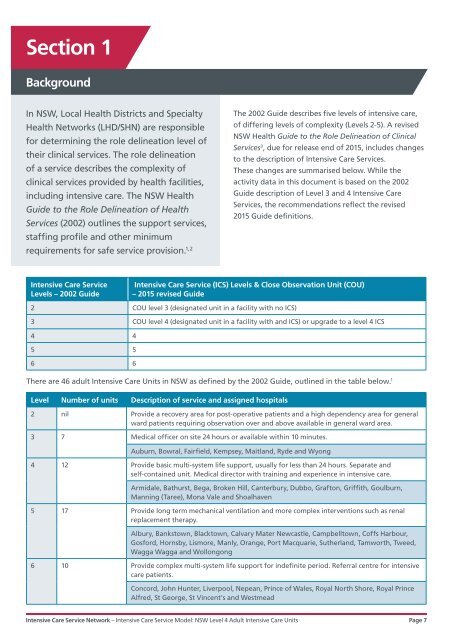Intensive Care Service Model NSW Level 4 Adult Intensive Care Units
1Olm7HQ
1Olm7HQ
You also want an ePaper? Increase the reach of your titles
YUMPU automatically turns print PDFs into web optimized ePapers that Google loves.
Section 1<br />
Background<br />
In <strong>NSW</strong>, Local Health Districts and Specialty<br />
Health Networks (LHD/SHN) are responsible<br />
for determining the role delineation level of<br />
their clinical services. The role delineation<br />
of a service describes the complexity of<br />
clinical services provided by health facilities,<br />
including intensive care. The <strong>NSW</strong> Health<br />
Guide to the Role Delineation of Health<br />
<strong>Service</strong>s (2002) outlines the support services,<br />
staffing profile and other minimum<br />
requirements for safe service provision. 1,2<br />
The 2002 Guide describes five levels of intensive care,<br />
of differing levels of complexity (<strong>Level</strong>s 2-5). A revised<br />
<strong>NSW</strong> Health Guide to the Role Delineation of Clinical<br />
<strong>Service</strong>s 3 , due for release end of 2015, includes changes<br />
to the description of <strong>Intensive</strong> <strong>Care</strong> <strong>Service</strong>s.<br />
These changes are summarised below. While the<br />
activity data in this document is based on the 2002<br />
Guide description of <strong>Level</strong> 3 and 4 <strong>Intensive</strong> <strong>Care</strong><br />
<strong>Service</strong>s, the recommendations reflect the revised<br />
2015 Guide definitions.<br />
<strong>Intensive</strong> <strong>Care</strong> <strong>Service</strong><br />
<strong>Level</strong>s – 2002 Guide<br />
<strong>Intensive</strong> <strong>Care</strong> <strong>Service</strong> (ICS) <strong>Level</strong>s & Close Observation Unit (COU)<br />
– 2015 revised Guide<br />
2 COU level 3 (designated unit in a facility with no ICS)<br />
3 COU level 4 (designated unit in a facility with and ICS) or upgrade to a level 4 ICS<br />
4 4<br />
5 5<br />
6 6<br />
There are 46 adult <strong>Intensive</strong> <strong>Care</strong> <strong>Units</strong> in <strong>NSW</strong> as defined by the 2002 Guide, outlined in the table below. 1<br />
<strong>Level</strong> Number of units Description of service and assigned hospitals<br />
2 nil Provide a recovery area for post-operative patients and a high dependency area for general<br />
ward patients requiring observation over and above available in general ward area.<br />
3 7 Medical officer on site 24 hours or available within 10 minutes.<br />
Auburn, Bowral, Fairfield, Kempsey, Maitland, Ryde and Wyong<br />
4 12 Provide basic multi-system life support, usually for less than 24 hours. Separate and<br />
self-contained unit. Medical director with training and experience in intensive care.<br />
Armidale, Bathurst, Bega, Broken Hill, Canterbury, Dubbo, Grafton, Griffith, Goulburn,<br />
Manning (Taree), Mona Vale and Shoalhaven<br />
5 17 Provide long term mechanical ventilation and more complex interventions such as renal<br />
replacement therapy.<br />
Albury, Bankstown, Blacktown, Calvary Mater Newcastle, Campbelltown, Coffs Harbour,<br />
Gosford, Hornsby, Lismore, Manly, Orange, Port Macquarie, Sutherland, Tamworth, Tweed,<br />
Wagga Wagga and Wollongong<br />
6 10 Provide complex multi-system life support for indefinite period. Referral centre for intensive<br />
care patients.<br />
Concord, John Hunter, Liverpool, Nepean, Prince of Wales, Royal North Shore, Royal Prince<br />
Alfred, St George, St Vincent's and Westmead<br />
<strong>Intensive</strong> <strong>Care</strong> <strong>Service</strong> Network – <strong>Intensive</strong> <strong>Care</strong> <strong>Service</strong> <strong>Model</strong>: <strong>NSW</strong> <strong>Level</strong> 4 <strong>Adult</strong> <strong>Intensive</strong> <strong>Care</strong> <strong>Units</strong> Page 7


